
Interstate 45 (I-45) is a major Interstate Highway located entirely within the U.S. state of Texas. While most primary Interstate routes which have numbers ending in "5" are cross-country north–south routes, I-45 is comparatively short, with the entire route located within Texas. Additionally, it has the shortest length of all the primary Interstates that have numbers ending in a "5". It connects the cities of Dallas and Houston, continuing southeast from Houston to Galveston over the Galveston Causeway to the Gulf of Mexico.

U.S. Route 290 is an east–west U.S. Highway located entirely within the state of Texas. Its western terminus is at Interstate 10 southeast of Segovia, and its eastern terminus is at Interstate 610 in northwest Houston. It is the main highway between Houston and Austin and is a cutoff for travelers wanting to bypass San Antonio on Interstate 10. Throughout its length west of Austin, US 290 cuts across mountainous hills comprising the Texas Hill Country and the Edwards Plateau; between Austin and Houston, the highway then travels through gradually hilly grasslands and pine forests comprising the Gulf Coastal Plains.

Interstate 76 (I-76) is an east–west Interstate Highway in the Western United States that runs from I-70 in Arvada, Colorado – near Denver – to an interchange with I-80 near Big Springs, Nebraska. The highway measures 187.29 miles (301.41 km) long, mostly situated in Colorado but approximately three miles (4.8 km) of which is in Nebraska. Along the route, the highway runs concurrent with US Route 6 (US 6), US 85 in the Denver metropolitan area, and US 34 from Wiggins to Fort Morgan. It has no auxiliary Interstates, but it has two business routes that are located in northeastern Colorado. This route is not connected with the other I-76 that spans from Ohio to New Jersey.
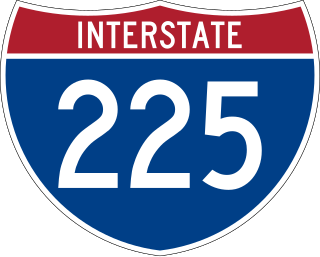
Interstate 225 (I-225) is an auxiliary Interstate Highway in the U.S. state of Colorado. The freeway is a 11.959-mile-long (19.246 km) connector spur route of I-25 that acts as an eastern bypass in the Denver metropolitan area and serves Aurora. It also provides direct access to Denver International Airport for the Denver Tech Center and the southern suburbs of Denver. I-225 is one of the two existing auxiliary Interstate Highways in Colorado and it is the only auxiliary route of I-25, as there are no auxiliary routes for I-25 in New Mexico and Wyoming. The route begins at I-25 in the Denver Tech Center and runs north to I-70 north of Aurora. It interchanges with State Highway 83 (SH 83), SH 30 and I-70 Business/US 40/US 287, known locally as Colfax Avenue. The freeway was first proposed in the 1950s along with the first Interstate Highways within Denver. Construction did not begin until 1964 at the I-70 interchange and proceeded south through Aurora until final completion in early 1976 with the final link to I-25 opening to traffic.

Beltway 8 (BW8), the Sam Houston Parkway, along with the Sam Houston Tollway, is an 88-mile (142 km) beltway around the city of Houston, Texas, United States, lying entirely within Harris County.
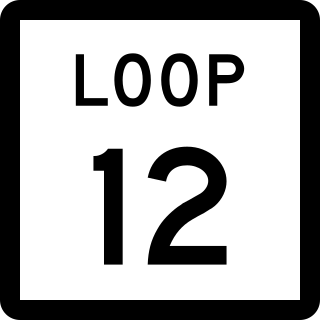
Loop 12 is a state highway that runs mostly within the city limits of Dallas, Texas. The western segment of the loop is named after General Walton Walker, who served and died in South Korea. During the 1950s and 1960s, Loop 12 was the outer beltway in the Dallas area, having since been supplanted by Interstate 635 (I-635), which is itself being supplanted by the President George Bush Turnpike. Loop 12 is, however, the only state highway in Dallas that forms a complete loop.

Interstate 635 (I-635) is a 37-mile-long (60 km) partial loop around Dallas, Texas, in the United States between I-20 in Balch Springs and State Highway 121 (SH 121) at the north entrance of the Dallas Fort Worth International Airport in Grapevine. It intersects I-35E at exits 27B and 27C but does not connect with I-35W. I-635 and a part of I-20 are collectively designated as the Lyndon B. Johnson Freeway; known locally as the LBJ Freeway, or simply LBJ. The roadway is named after Lyndon B. Johnson, the former U.S. senator from Texas and the 37th vice-president and 36th president of the U.S. Where I-635 ends at I-20, I-20 continues the LBJ Freeway designation heading west. Since the portion of I-20 between Spur 408 to I-635 retains the same names as I-635, the two highways are considered three-quarters of the beltway around Dallas. Together with Spur 408, a portion of Loop 12, and a portion of I-35E, I-635 and I-20 complete the beltway.

The Westpark Tollway, also Fort Bend Westpark Tollway, is a controlled-access toll road in Texas, serving western Houston and Harris County, and northeastern Fort Bend County. Construction on the facility began in 2001 and portions of the road were opened to traffic in May 2004. Construction of the roadway was completed in August 2005. The Westpark Tollway begins on Westpark Drive just past the South Rice Avenue intersection in the Uptown District of Houston and runs approximately 22 miles (35 km) west to Farm to Market Road 1093 just past Farm to Market Road 723 in Fulshear, Texas. It runs roughly parallel and to the south of Westheimer Road in Harris County and concurrently with FM 1093 in Fort Bend County.
A directional interchange, colloquially known as a stack interchange, is a type of grade-separated junction between two controlled-access highways that allows for free-flowing movement to and from all directions of traffic. These interchanges eliminate the problems of weaving, have the highest vehicle capacity, and vehicles travel shorter distances when compared to different types of interchanges.
The Fort Bend Parkway Toll Road is the Fort Bend County portion of a controlled-access toll road connecting Sienna in eastern Fort Bend County to US 90A in southwestern Harris County. It is administered by the Fort Bend County Toll Road Authority (FBCTRA). The Harris County Toll Road Authority (HCTRA) administers the Harris County segment of the road — from just south of Beltway 8 at the county line to US 90A — and uses its purple pentagonal shield labeled as Fort Bend Toll Road. It is proposed to reach a northern terminus at the southwestern corner of Interstate 610 in the future, and SH 99 at its southern terminus.
The Harris County Toll Road Authority maintains and operates a 103-mile (165.8 km) toll road system in the Greater Houston area of Texas, United States. Its headquarters are located in Houston's Fairbanks/Northwest Crossing neighborhood.

Interstate 270 (I-270) is a seven-mile-long (11 km) auxiliary Interstate Highway located in the northeastern part of the Denver metropolitan area in the US state of Colorado. It overlaps U.S. Highway 36 (US 36) for its entire length and is also a part of the Dwight D. Eisenhower Highway, which spans from I-270 and the Capital Beltway in Bethesda, Maryland, to I-80/US 101 in San Francisco, California. The western terminus of I-270 is at the interchange with I-25 and US 36. It heads eastward to an interchange with I-76, where the mileposts reset because of a previous freeway extension. The freeway heads southeast and comes to meet Vasquez Boulevard, where it enters Commerce City. The road crosses Quebec Street before ending at I-70.
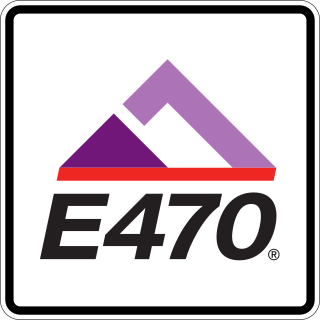
E-470 is a 47-mile-long (76 km) controlled-access toll road that traverses the eastern portion of the Denver metropolitan area in the US state of Colorado. It is the eastern half of the 470 beltway that serves Meridian, Parker, Aurora, Denver International Airport, and Brighton.

Northwest Parkway is a 9.05-mile (14.56 km) limited-access toll road that runs from US 36 to the I-25/E-470 interchange. Both terminus are in Broomfield, northwest of Denver. In combination with E-470 and State Highway 470, Northwest Parkway forms a partial beltway of approximately 83 miles (134 km) around the Denver metropolitan area. Some 18 miles (29 km) lie between the west end of Northwest Parkway and the northwest end of SH 470, the opposite end of the beltway.

State Highway 121 (SH 121) is a 30.425 mile (48.96 km) long state highway in the U.S. state of Colorado. SH 121's southern terminus is at Waterton Road near Littleton, and the northern terminus is at U.S. Route 287 (US 287) in Broomfield.
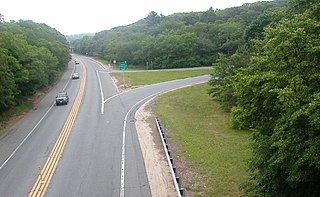
A two-lane expressway or two-lane freeway is an expressway or freeway with only one lane in each direction, and usually no median barrier. It may be built that way because of constraints, or may be intended for expansion once traffic volumes rise. The term super two is often used by roadgeeks for this type of road, but traffic engineers use that term for a high-quality surface road. Most of these roads are not tolled.
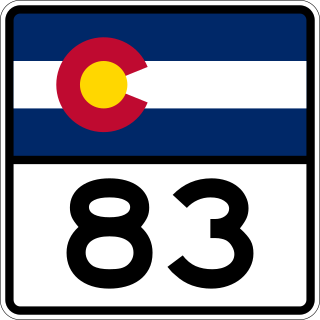
State Highway 83 (SH 83) is a state highway that is located along the Front Range in the U.S. State of Colorado. Spanning about 56.2 miles (90.4 km) from the SH 21 interchange in northern Colorado Springs and SH 2 in Denver, the highway follows a south–north route, paralleling Interstate 25 to the east and serving rural areas. Along with I-25, it is one of the only two routes in the Colorado State Highway System that directly connects Denver and Colorado Springs.
In the US state of Colorado, Interstate 25 (I-25) follows the north–south corridor through Colorado Springs and Denver. The highway enters the state from the north near Carr and exits the state near Starkville. The highway also runs through the cities of Fort Collins, Broomfield, Loveland, and Pueblo. The route is concurrent with U.S. Route 87 (US 87), which is unsigned, through the entire length of the state. I-25 replaced US 87 and most of US 85 for through traffic.
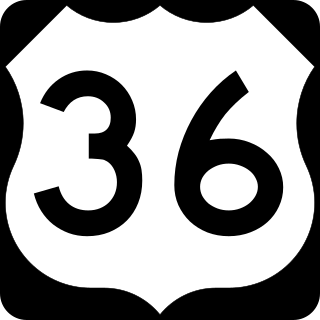
U.S. Route 36 is a United States highway that travels from Rocky Mountain National Park, Colorado to Uhrichsville, Ohio. In Colorado, the highway traverses an east–west route mostly in the northern portion of the Great Plains. At its west end, the road connects several small mountain towns such as Estes Park and Lyons to the larger metropolitan areas of Boulder and Denver. As it continues eastward, it connects to several other small towns and rural highways on the plains before crossing the state line into Kansas.

















